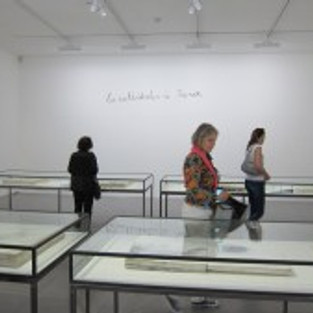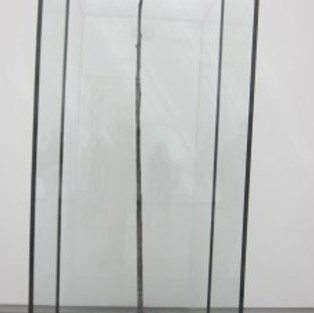Rodin/Kiefer at the Musée Rodin in Paris
- artandcakela
- Jun 3, 2017
- 6 min read

Rodin/Kiefer; Musée Rodin, Paris. Photo Credit Gary Brewer.
Rodin/Kiefer at the Musée Rodin in Paris
By Gary Brewer
“For beauty is nothing but the beginning of terror, that we are still able to bear…”
Rainer Maria Rilke, Duino Elegies
“How strange it is, to be standing leaning against the current of time.” W.G. Sebald
When I heard about this exhibit of Rodin and Kiefer I immediately envisioned the plaster casts and molds of Rodin that I knew well from the collection at the Legion of Honor in San Francisco. The seams on the plaster casts add an urgency and a sense of process and transformation to Rodin’s sculptures that give them a contemporary feel. The molds for the casts are crude appearing objects, transports for raw material to be transformed into refined objects. Kiefer was drawn to the casts and especially to the molds as objects that contained a past and a future and that their hidden negative spaces had to be envisioned by the viewer; the past and the present compressed and metamorphosed into something new.
Rodin was a romantic artist, the physical expressivity of his sculpture a marriage of a tough sense of realism conveyed through a ‘symbolist’ vernacular of poses and expressions. There is a painting of the “Thinker” by Edward Munch in the collection that Munch had painted in the garden of this studio-now museum, it brought to mind that connection, of stylized figurative distortions communicating an interior subjective emotion on a mythic scale. Kiefer is a romantic artist whose visual vocabulary is often that of architecture as an image to communicate the tragedy of history, of German history and of the histories of ideas through time that can lead to horror. His use of plants and sunflowers give one a sense of rebirth, renewal and of transformation, that the buried dead can become the seeds of a new generation.
I am in Paris as I write these words but before we left the states I decided to read a French novel and chose the Hunchback of Notre Dame by Victor Hugo. I was astonished to learn that the main thrust of this novel was to awaken an interest in the preservation of Gothic-Medieval architecture which was being torn down and destroyed at that time in the 1830’s, and of the need for the restoration of Notre Dame in particular. Rodin was deeply influenced by Hugo and became an enthusiast for Gothic French architecture; in 1914 he published a book “The Cathedrals of France.”
Kiefer has titled this body of works, “The Cathedrals of France” in homage to Rodin’s book. In his paintings, images of spires and towers reference the towers of Kiefer’s own massive studio-installation complex at Barjac, in southern France. They are drawn, etched and embossed into thick material, paint or some other substance that he scraps and carves into, to render powerful expressive visions of these structures. Onto these he pours and splatters hot lead that exquisitely convey organic forms suggesting plant fronds, vascular systems, sea fans and other organic forms, their powerful physicality shape-shifting between image and matter. He pours and applies paint and other materials to create congealed surfaces some of which, after pouring hot lead on them, he peals back, revealing the underside which acts like a print picking up material from underneath like a molten mono print.
Kiefer has also created a room filled with vitrines of large painted and drawn books that make free use of Rodin’s exquisite erotic watercolors and drawings of female nudes as well as his studies for ornamental elements in buildings that include the female form. In these works the expressive force of Kiefer’s sense of touch, of materials and of accident is beautifully displayed, these watercolors and drawings feel fresh and spontaneous and harken back to the early romantic watercolors that Kiefer produced before his epic, straw, pitch and lead paintings began.
In the first room of Kiefer’s installation three monumental paintings hang along with several vitrines, one with a spiral ladder, a DNA helix climbing out of the primal poetic matter of earth with a group of Rodin’s plaster casts buried beneath. Another contains a sunflower whose seeds have been gold leafed, seeds still in the dried heads and seeds that have fallen onto an open book-the book painted an earthy lead blue; a metaphor of the cycle of life-death and regeneration, the conveyance of ideas and of the earth. The room also contains antique plaster molds that Kiefer purchased and placed on metal shelves whose patina of age add to the impact.

Rodin/Kiefer; Musée Rodin, Paris. Photo Credit Gary Brewer.
One moves from the chapel to the main building that houses Rodin’s sculptures and art collection by walking through the beautiful gardens. The ‘Thinker, and ‘Balzac’ greet you as you walk from one building to the other. The entrance into this building is the entrance into the imagination of Rodin where the germination of his ideas and experimentations are contained in an ornate 18th century mansion whose tall arched windows and mirrors with their amber patina of age, add a sublime majesty to the experience. It was the displays of experimental works, assemblages of different elements from completed sculptures, the plaster molds and casts, many displayed for the first time, which spoke most intimately to Kiefer’s creations.
There is a piece Rodin made in 1900, “Absolution”, that is an amalgam of different elements from preexisting sculptures. The “Earth and Martyr’s” head and the torso from “Seated Ugolino” are combined with a canvas cloth dipped in plaster and draped over the hybrid figure. The folds of fabric are fixed in the plaster, which over the years has fractured adding a pathos and poetry to this work whose mysterious quality brings to mind the short story “The Unfinished Masterpiece” by Balzac. One cannot know what Rodin’s intentions were, however because of his love of antiquities, of ruins and of fragments of ancient sculpture that he collected, we can imagine that he was considering another avenue of expression, one that could be from the hands of Kiefer himself.
Rodin worked there until the end of his life and offered the government his entire body of work, archives and art collection if they would create a museum to contain it. It was a sublime journey to see this powerful dialogue between two romantic artists separated by 100 years of history. To wander through the gardens and to see Rodin’s sculptures more beautifully displayed than I have ever seen his work before, and the museums poetic choice to allow the green patina of aging bronze to color the sculptures and stain their pedestals-giving his work a more noble romantic aura, was in some ways to see Rodin for the first time.

Rodin/Kiefer; Musée Rodin, Paris. Photo Credit Gary Brewer.
The many variations of figurative expression that Rodin explored to arrive at his Burghers of Calais were a deeply moving experience. Throughout the gardens there were studies for the figures of the men who offered their lives to the English in order to spare the lives of the people of Calais during the Hundred Years War. Clothed and unclothed each one is a variation of the theater of the body’s capacity to convey emotion, surrender, sacrifice and sorrow.
The genesis for this exhibit in part comes from Rodin’s stated wishes that his vast archive of ‘lovingly collected sculptures from antiquity, his molds and casts and other archived materials, be used for the education of artists in the future’. The museum asked Kiefer’s in 2013 to come to the museum and research its collection to create a body of work to celebrate the centennial of Rodin’s death.
The building and gardens have a rich cultural history as well. The building, built in 1730 was initially a private residence, then it was rented by the Society of the Sacred Hearts of Jesus, the chapel in which Kiefer’s work is displayed was built after the original building for the religious orders needs. When they became financially insolvent the building and grounds were returned to the state and the building was left vacant for years. In the early 20th century artists started to rent rooms for studios; Jean Cocteau, Isadora Duncan, Rainer Maria Rilke and Matisse all rented space, Matisse rented space there for his school of art. It was Rilke who later became Rodin’s secretary, who wrote a letter to Rodin letting him know about the building.
The layers of history which overlap in this exhibit, the many brilliant souls who inhabited this building, creating and working, adds an undertow to the currents which we are all moved by, of the forces of history that shape us, the histories that these two artist seek to capture; it is the stain of history memorialized in matter.
#art #painting #AnselmKiefer #VictorHugo #onlineartmagazine #WGSebald #Paris #RodinKiefer #artgallery #gallery #museum #artandcake #Rodin #artchitecture #artexhibition #ArtandCakeLA #fineart #artist #arts #TheCathedralsofFrance #artreview #NotreDame #Kiefer #artmuseum #sculpture #artexhibit #artmagazine #RainerMariaRilke #france #ArtandCulture #exhibition #MuseeRodin #augusterodin #GothicFrencharchitecture #exhibit #arthistory #EdwardMuch




































